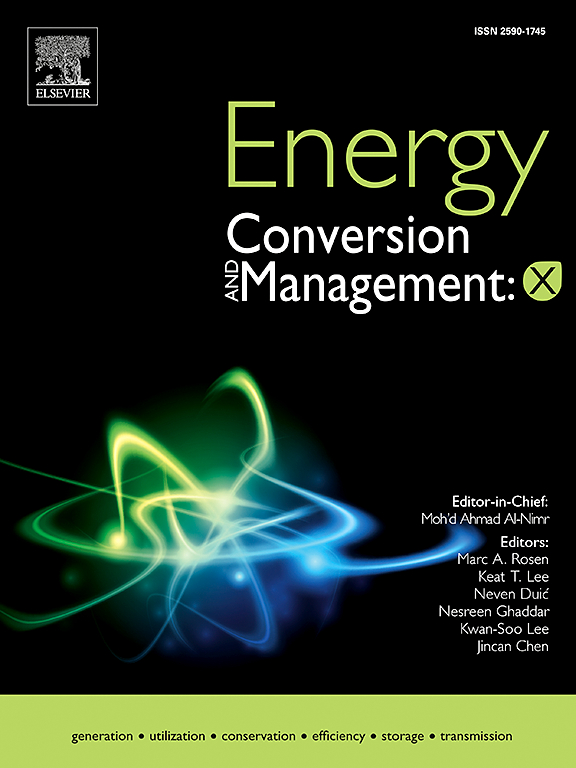Contactless external manifold design of a kW-scale solid oxide electrolysis cell stack and analysis of its impact on the internal stack environment
IF 7.1
Q1 ENERGY & FUELS
引用次数: 0
Abstract
A solid oxide electrolysis cell (SOEC) technology emerges as a promising solution for producing environmentally friendly green hydrogen. However, stacking multiple repeating units to maximize hydrogen production introduces significant challenges, particularly non-uniform distribution of reacting gases and temperature across the cell-layers in internal manifold stacks. To address these issues, external manifold stacks are proposed as a potential solution. However, conventional external manifold configuration utilizes a fastening method that directly connects the stack and external manifold to supply reacting gases. This approach often fails to maintain uniform fastening strength due to thermal expansion of the stack, leading to gas leakage and degradation of electrochemical cells. To overcome these limitations, this study proposes a contactless external manifold design that eliminates direct contact between the stack and the external manifold while focusing on a detailed analysis of heat and mass transport characteristics within the stack and the resulting electrochemical distributions. Meanwhile, using the contactless configuration creates not only a flow path entering the stack but also a newly formed bypass outside the stack, with simulation results revealing that excessive air leakage occurs through this bypass. To resolve this issue, a flow resistance circuit is constructed to derive the flow resistance of each airflow path. Based on the calculated flow resistances, a hook-shaped flow resistance structure is introduced to ensure that the desired airflow rate enters the stack. A comparative analysis is conducted among three configurations: an external manifold stack with the hook-shaped resistance structure, an external manifold stack without the resistance structure, and an internal manifold stack. This analysis elucidates the relationships among pressure, species distribution, temperature, and electrochemical distribution for each configuration. The results demonstrate that the external manifold stack with the hook-shaped resistance structure provides the most uniform internal environment for cells. Additionally, an air ratio study is conducted to verify the validity of the proposed external manifold design under various conditions, confirming its applicability across a wide range of operating conditions and the reliability of the flow resistance structure design methodology.

千瓦级固体氧化物电解电池堆非接触式外流形设计及其对堆内环境的影响分析
固体氧化物电解电池(SOEC)技术是生产环境友好型绿色氢的一种有前途的解决方案。然而,堆叠多个重复单元以最大限度地提高氢气产量会带来重大挑战,特别是在内部歧管堆的电池层中,反应气体和温度分布不均匀。为了解决这些问题,建议将外部流形堆栈作为一种潜在的解决方案。然而,传统的外部歧管配置采用直接连接堆栈和外部歧管的紧固方法来提供反应气体。这种方法往往不能保持均匀的紧固强度,由于热膨胀的堆栈,导致气体泄漏和电化学电池的降解。为了克服这些限制,本研究提出了一种非接触式外部歧管设计,该设计消除了堆与外部歧管之间的直接接触,同时专注于详细分析堆内的热量和质量传输特性以及由此产生的电化学分布。同时,采用非接触式配置不仅会形成进入堆内的流道,还会在堆外形成新的旁路,仿真结果表明,通过该旁路会发生过多的漏风。为了解决这个问题,我们构造了一个流动阻力电路来推导每个气流路径的流动阻力。在计算流阻的基础上,引入了钩形流阻结构,以保证进入烟囱的气流达到期望的流速。对比分析了带钩形阻力结构的外流形堆、不带阻力结构的外流形堆和内流形堆三种结构形式。这一分析阐明了压力、物质分布、温度和电化学分布之间的关系。结果表明,具有钩形阻力结构的外部流形堆为电池提供了最均匀的内部环境。此外,还进行了空气比研究,以验证所提出的外部歧管设计在各种条件下的有效性,确认其在广泛的工作条件下的适用性以及流阻结构设计方法的可靠性。
本文章由计算机程序翻译,如有差异,请以英文原文为准。
求助全文
约1分钟内获得全文
求助全文
来源期刊

Energy Conversion and Management-X
Multiple-
CiteScore
8.80
自引率
3.20%
发文量
180
审稿时长
58 days
期刊介绍:
Energy Conversion and Management: X is the open access extension of the reputable journal Energy Conversion and Management, serving as a platform for interdisciplinary research on a wide array of critical energy subjects. The journal is dedicated to publishing original contributions and in-depth technical review articles that present groundbreaking research on topics spanning energy generation, utilization, conversion, storage, transmission, conservation, management, and sustainability.
The scope of Energy Conversion and Management: X encompasses various forms of energy, including mechanical, thermal, nuclear, chemical, electromagnetic, magnetic, and electric energy. It addresses all known energy resources, highlighting both conventional sources like fossil fuels and nuclear power, as well as renewable resources such as solar, biomass, hydro, wind, geothermal, and ocean energy.
 求助内容:
求助内容: 应助结果提醒方式:
应助结果提醒方式:


